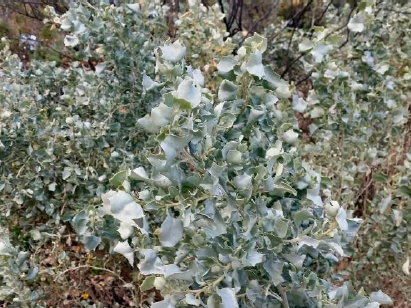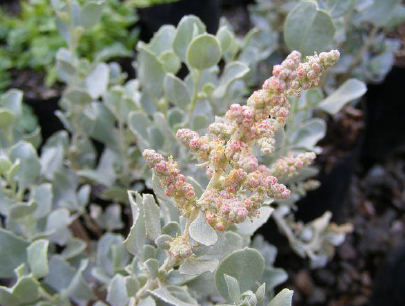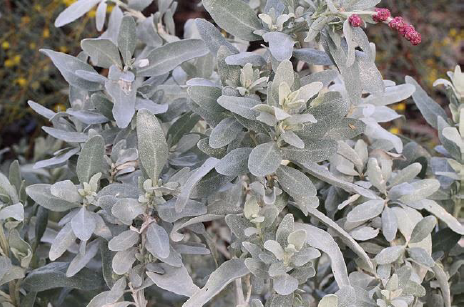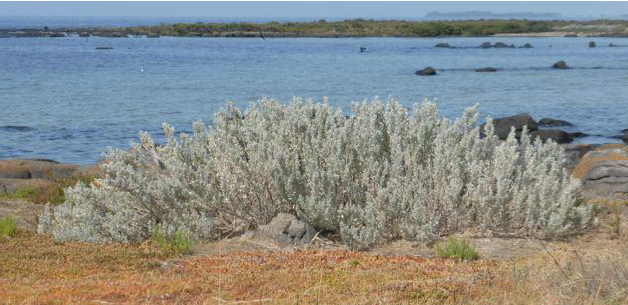The most common Australian native bush growing in Sanctuary Lakes are the Saltbush. When Greg Norman first inspected the area, he was impressed by the presence of this silvery grey-blue shrub and thought they were an ideal bush to be grown in the rough on a links course plus they would give an individual and distinctively Australian look to the course.The most common Australian native bush growing in Sanctuary Lakes are the Saltbush. When Greg Norman first inspected the area, he was impressed by the presence of this silvery grey-blue shrub and thought they were an ideal bush to be grown in the rough on a links course plus they would give an individual and distinctively Australian look to the course.
The name Saltbush derives from the simple fact that the plants retain salt in their leaves and are able to grow in areas affected by soil salination.

Old Man Saltbush Atriplex nummularia
The story of the Saltbush in the Sanctuary Lakes area has been quite dramatic. Pre -European, they were a widespread and common shrubbery. Indigenous groups used the Saltbush which they called “Purngep” or “Binga” in baking, where the seeds were ground and mixed into dampers. The leaves were used for medicinal purposes, and often added to water as skin cleansers for sores, burns and wounds. The first European settlers in our district, Drayton, Irvine and Chirnside, cleared the land for Cattle grazing and thereby ridding the Saltbush. But the removal of the Saltbush caused increased levels of salt in the soil to rise and killed salt-sensitive vegetation, spoilt drinking water, destroying natural ecosystems and created patches of bare ground. Much later in the early- 20th century, the Saltbush were replanted and ironically became a supplementary fodder for the sheep and cattle. When Cheetham Salt Works closed in the 1990s numerous Saltbush were planted over the wetlands to help desalinate the soil and it probably would have been these shrubs that caught Greg Norman’s eye.
There are over sixty species of Saltbush in Australia. The two most predominant in Sanctuary Lakes are the Coastal Saltbush and the Old Man Saltbush.

Old Man Saltbush Atriplex nummularia
The largest of the Australian saltbushes, Old Man Saltbush can grow up to two and a half metres high and four metres wide. Its leaves vary from one to five centimetres long, have a scaly coating which gives them an attractive blue and silvery grey colour. The shape of the leaves may vary considerably from elliptical to almost circular, both on the same plant and in different populations of the species.
As many Golfers who have had the misfortune of driving their ball into the Old Man’s shrubbery know, it has at its base, a mass of woody lattice stems which branch and criss-crosses along at ground level, utilising a taproot which connects to a moderate to deep root system.
Throughout the year, Old Man Saltbush produces very small flowers which are wind pollinated. Male and female flowers occur on separate plants. The female flowers are in dense clusters along panicles about 20 cm long and the male flowers are in disjunct globules at the ends of branches. After fertilisation, leafy bracts of the female flower become enlarged and surround the developing seed. These fruiting bracteoles are attached only at the base and are approximately one centimetre wide in the shape of a fan.Throughout the year, Old Man Saltbush produces very small flowers which are wind pollinated. Male and female flowers occur on separate plants. The female flowers are in dense clusters along panicles about 20 cm long and the male flowers are in disjunct globules at the ends of branches. After fertilisation, leafy bracts of the female flower become enlarged and surround the developing seed. These fruiting bracteoles are attached only at the base and are approximately one centimetre wide in the shape of a fan.Coastal Saltbush

Coastal Saltbush Atriplex cinerea on the Northern Boulevard

Coastal Saltbush Atriplex cinerea on Cheetham Wetland
Besides there being prominent hedgerows on the Sanctuary Lake’s Boulevards and Golf course, the Coastal Saltbush, as its name suggests, can also be seen on our coastline, the Cheetham Wetlands.
The Coastal Saltbush, Atriplex cinerea is found in sheltered parts along the coastal fringe of Melbourne’s Port Phillip Bay. It grows to a bush of up to two meters high and five metres wide and has striking silver-grey lance-shaped to oblong leaves, up to 10 cm long with aThe Coastal Saltbush, Atriplex cinerea is found in sheltered parts along the coastal fringe of Melbourne’s Port Phillip Bay. It grows to a bush of up to two meters high and five metres wide and has striking silver-grey lance-shaped to oblong leaves, up to 10 cm long with ablunt apex and a short stalk. Unlike most other Saltbush plants, it can grow in part shade waterlogged soils and even dry soils.
The Coastal Saltbush, Atriplex cinerea is found in sheltered parts along the coastal fringe of Melbourne’s Port Phillip Bay. It grows to a bush of up to two meters high and five metres wide and has striking silver-grey lance-shaped to oblong leaves, up to 10 cm long with aThe Coastal Saltbush, Atriplex cinerea is found in sheltered parts along the coastal fringe of Melbourne’s Port Phillip Bay. It grows to a bush of up to two meters high and five metres wide and has striking silver-grey lance-shaped to oblong leaves, up to 10 cm long with ablunt apex and a short stalk. Unlike most other Saltbush plants, it can grow in part shade waterlogged soils and even dry soils.Like most Australian Saltbush, Coastal are dioecious (separate male and female plants). Female flowers in axillary clusters arising from the axils or junctions between stem and leaf. Males in large globular clusters on a long thick spike or spicate panicle. The fruiting bracts are fused below the middle, they are sometimes swollen at the base and become woody at maturity.
The Coastal Saltbush is unusual in that it produces a habitat around itself. Walking along the Boulevards and the fringes of the Golf Course, where there are hedgerows of Coastal Saltbush you will invariably see couples of Blue Fairy Wrens. What is not immediately obvious is that these little birds have an affinity to the Coastal Saltbush. The Coastal’s habitat provides dense shelter for the delicate Wrens, who are susceptible to cats and being chased off by noisy miners. The Saltbush also is an invaluable habitat for a variety of insects, butterflies and moths, a mouth-watering diet for any Blue Wren. Food and shelter, what more would you want as a little pretty bird!
At the beginning of this Rubik I introduced the Saltbush as a food source for Indigenous Australians but various species of Saltbush were also part of the European diet. The generic name Atriplex originated in Latin and was applied to the edible Oraches, a medieval spinach like vegetable which is still grown in warm weather climates and now called Garden Orache.
For those of you who are experimenting and enjoying cooking and tasting Bush Tucker, why not try Saltbush? The leaves are very edible, salty in flavour and rich in protein, antioxidants and minerals. Old Man Saltbush’s leaves in particular, should be treated like a leafy vegetable. They can be enjoyed blanched, sautéed, wrapped around meat or fish, used in salads, or for stuffing poultry. Alternatively, they may be dried and used as a salty herb or sprinkle.
Bon Appetit or “Tuckers Up!”